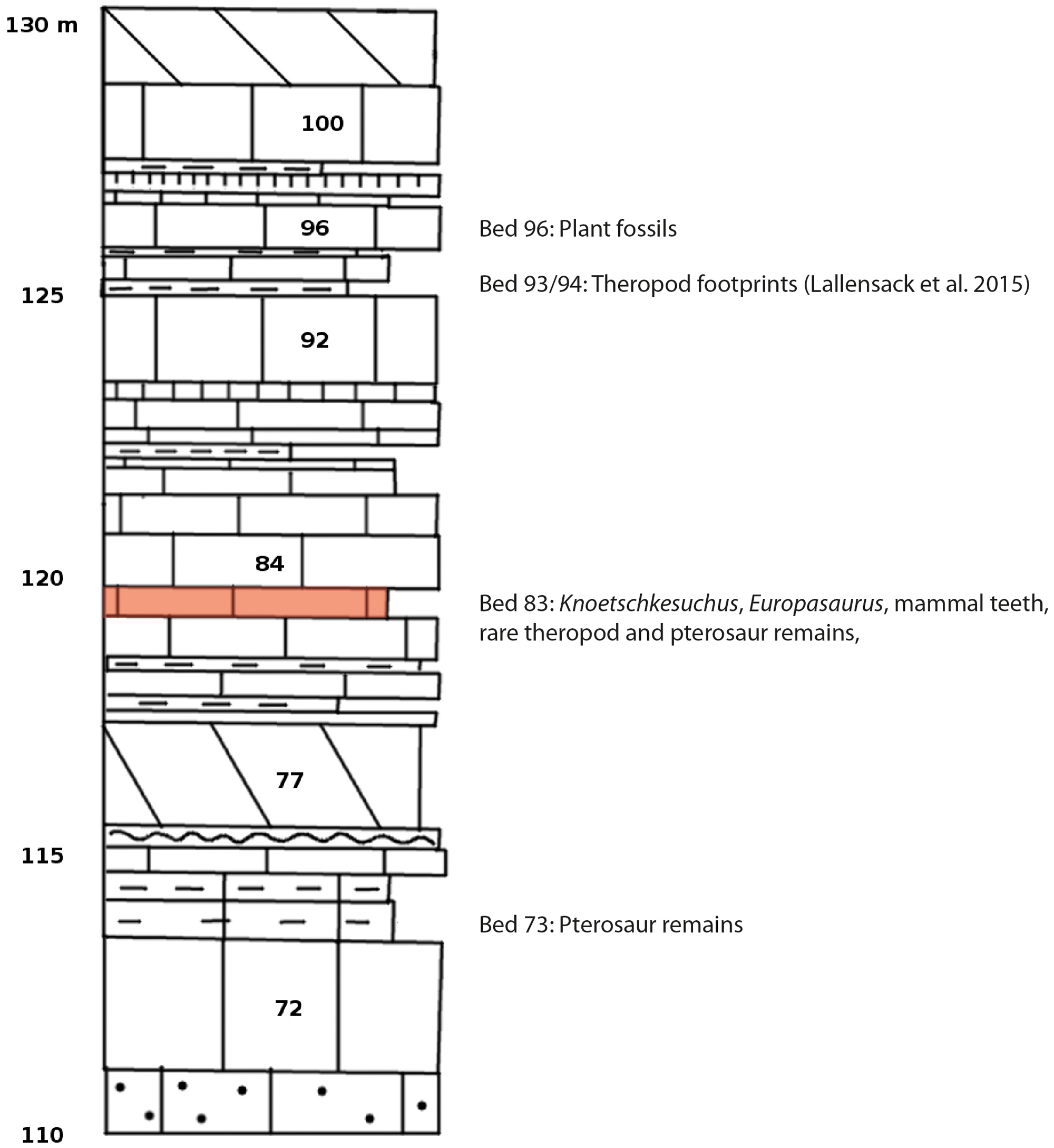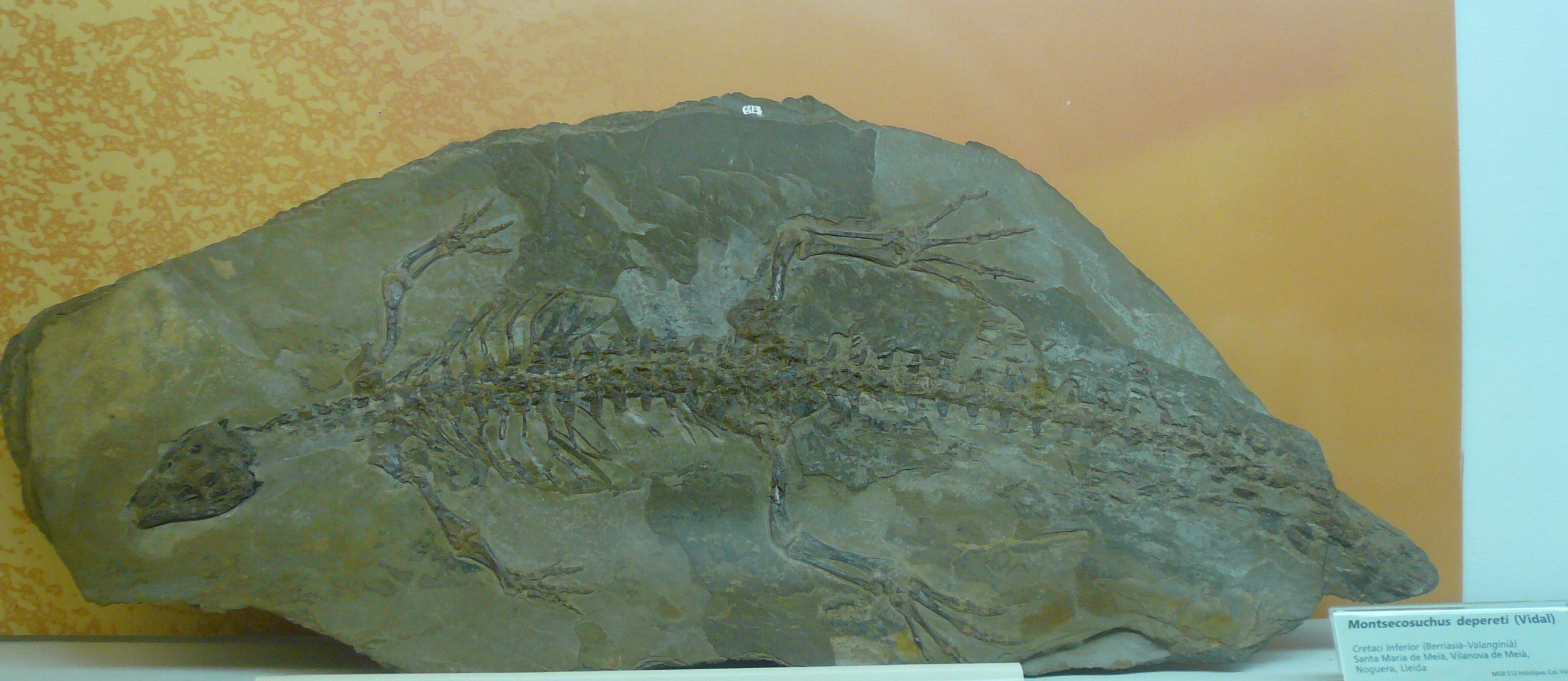|
Atoposaurid
Atoposauridae is a Family (biology), family of crocodile-line archosaurs belonging to Neosuchia. The majority of the family are known from Late Jurassic to Early Cretaceous marine deposits in France, Portugal, and Bavaria in southern Germany. The discovery of the genus ''Aprosuchus'', however, extends the duration of the lineage to the end of the Cretaceous in Romania. Classification Phylogeny Cladogram modified from Buscalioni and Sanz (1988) and Buscalioni and Sanz (1990): References Late Jurassic crocodylomorphs Taxa named by Paul Gervais Prehistoric reptile families {{paleo-archosaur-stub ... [...More Info...] [...Related Items...] OR: [Wikipedia] [Google] [Baidu] |
Knoetschkesuchus
''Knoetschkesuchus'' is a genus of small atoposaurid crocodylomorph from the Late Jurassic of Germany and Portugal. Two species are known: the German species ''K. langenbergensis'', described by Schwarz and colleagues in 2017 based on two partial skeletons and various isolated bones; and the Portuguese species ''K. guimarotae'', named from over 400 specimens including several partial skeletons. ''Knoetschkesuchus'' was a small and short-snouted crocodilian, measuring about in length, that primarily fed on small prey, including invertebrates, amphibians, and mammals. This specialization towards small prey ecologically separated ''Knoetschkesuchus'' from most of the other diverse crocodilians that it lived with in the island ecosystem of Jurassic Europe. Both species were formerly recognized as belonging to ''Theriosuchus''; ''K. guimarotae'' was initially named as ''T. guimarotae'', and specimens of ''K. langenbergensis'' were initially referred to ''T. pusillus'' upon their dis ... [...More Info...] [...Related Items...] OR: [Wikipedia] [Google] [Baidu] |
Theriosuchus
''Theriosuchus'' is an extinct genus of atoposaurid neosuchian from Late Jurassic to Early Cretaceous of Europe (Hungary & southern England), Southeast Asia (Thailand) and western North America (Wyoming), with fragmentary records from Middle Jurassic and Early Cretaceous sites in China, Morocco, and Scotland. Taxonomy Three valid species are currently recognized: ''Theriosuchus pusillus'' from southern England, ''T. grandinaris'' from Thailand, and ''T. morrisonensis'' from the Morrison Formation of North America. ''Theriosuchus'' was previously assigned to Atoposauridae, but a 2016 cladistic analysis recovered it as a neosuchian more closely related to members of the family Paralligatoridae than to atoposaurids. Two species previously assigned to this genus, ''Theriosuchus ibericus'' and ''T. symplesiodon'', have been reassigned to the new genus ''Sabresuchus''. On the other hand, ''Theriosuchus guimarotae'' from Portugal has been reassigned to ''Knoetschkesuchus ''Knoets ... [...More Info...] [...Related Items...] OR: [Wikipedia] [Google] [Baidu] |
Alligatorium
''Alligatorium'' is an extinct genus of atoposaurid crocodylomorph from Late Jurassic marine deposits in France. Systematics The type species is ''A. meyeri'', named in 1871 from a single specimen from Cerin, eastern France. Two more nominal species, ''A. franconicum'', named in 1906, and ''A paintenense'', named in 1961, are based on now-missing specimens from Bavaria, southern Germany, and were synonymized into a single species, for which ''A. franconicum'' has priority. A 2016 review of Atoposauridae removed ''A. franconicum'' from ''Alligatorium'' and placed at Neosuchia ''incertae sedis''. ''Alligatorium depereti'', described in 1915, was reassigned to its own genus, ''Montsecosuchus ''Montsecosuchus'' is an extinct genus of atoposaurid crocodylomorphs. It is the replacement generic name for ''Alligatorium depereti'', which was described in 1915 from the Montsec Lithographic Limestone quarry of Spain. Fossils found from this ...'', in 1988. References Late Jura ... [...More Info...] [...Related Items...] OR: [Wikipedia] [Google] [Baidu] |
Atoposaurus
''Atoposaurus'' is an extinct genus of crocodylomorph. It is the type genus of the family Atoposauridae. Fossils have been found that were Late Jurassic in age from two distinct species in France and Germany. One interesting feature of ''Atoposaurus'' is that it lacked dorsal scutes, a common characteristic of atoposaurids as well as most crurotarsans. The absence of scutes, along with its relatively small size (specimens reach lengths of up to 17 cm), narrow supratemporal fossae, wide occipital region, thin postorbital bar, and smooth ornamentation, has led some paleontologists to believe that it is perhaps a juvenile form of another genus within Atoposauridae, most likely ''Alligatorellus''. History of the holotype The Teylers Museum has a holotype specimen ''Atoposaurus oberndorfi'' that was bought by curator J.G.S. van Breda in 1863 from Adam August Krantz (1809-1872), dealer in minerals in Bonn from 1850 onwards. The purchase was made along with the other holotypes ... [...More Info...] [...Related Items...] OR: [Wikipedia] [Google] [Baidu] |
Montsecosuchus
''Montsecosuchus'' is an extinct genus of atoposaurid crocodylomorphs. It is the replacement generic name for ''Alligatorium depereti'', which was described in 1915 from the Montsec Lithographic Limestone quarry of Spain. Fossils found from this locality are from the Early Cretaceous, being Upper Berriasian-Lower Valanginian in age, belonging to the La Pedrera de Rúbies Formation While many publications concerning atoposaurids after 1915 have included mentions of ''A. depereti'', none has offered a redescription or revision of the species, though some recognized that great differences existed between it and other members of the genus. In these publications, the skull of ''A. depereti'' was shorter in relation to body length than any other species of ''Alligatorium'' (being less than half of the presacral length), and this may have been evidence for the genetic distinction of the species, although no replacement name was proposed. However, better preparation of the holotype speci ... [...More Info...] [...Related Items...] OR: [Wikipedia] [Google] [Baidu] |
Neosuchia
Neosuchia is a clade within Mesoeucrocodylia that includes all modern extant crocodilians and their closest fossil relatives. It is defined as the most inclusive clade containing all crocodylomorphs more closely related to ''Crocodylus niloticus'' (the Nile Crocodile) than to ''Notosuchus terrestris''. Members of Neosuchia generally share a crocodilian-like bodyform adapted to freshwater aquatic life, as opposed to the terrestrial habits of more basal crocodylomorph groups. The earliest neosuchian is suggested to be the Early Jurassic ''Calsoyasuchus'', which lived during the Sinemurian and Pliensbachian stages in North America. It is often identified as a member of Goniopholididae, though this is disputed, and the taxon may lie outside Neosuchia, which places the earliest records of the group in the Middle Jurassic. Characteristics A tooth notch between the maxilla and premaxilla is a basal characteristic of the Neosuchia, although it is lost in some more derived forms, most nota ... [...More Info...] [...Related Items...] OR: [Wikipedia] [Google] [Baidu] |
Aprosuchus
''Aprosuchus'' is a genus of small-bodied Maastrichtian atoposaurid Eusuchian from the Hateg Basin, Romania. Discovery and naming ''Aprosuchus'' is known from an incomplete three-dimensional skull and closely associated mandibles (Holotype UBB V.562/1) as well as a cervical vertebrae found in association with the cranial remains (referred specimen UBB V.562/2). The fossils were found in Maastrichtian sediments of the Pui Gater locality in the Hateg Basin in modern day Transylvania, Romania. The name derives from the Hungarian "apró" meaning small and the Ancient Greek σοῦχος, soukhos ("crocodile"). The species name ghirai honors Ioan Ghira from the Babeș-Bolyai University, Cluj-Napoca, for his contributions to Herpetology. Description ''Aprosuchus'' was a small sized brevirostrine Eusuchian with an estimated body length of 600 mm. It differs from other crocodylomorphs through large palpebral strongly fused to the orbital margin of the prefrontals and frontals and ... [...More Info...] [...Related Items...] OR: [Wikipedia] [Google] [Baidu] |
Alligatorellus
''Alligatorellus'' is an extinct genus of Atoposauridae, atoposaurid crocodyliform found in France that was related to ''Atoposaurus''. A skeleton of ''Alligatorellus'' has also been found in the Solnhofen Limestone of Kelheim, Germany. The limestone was deposited in a marine environment and the individual may have washed into a lagoon where it was fossilized. Remains of four crinoids that lived in the lagoon are found in the same block as the skeleton. The skeleton includes osteoderms and limb bones, which are three-dimensionally preserved. The German skeleton shows more details of atoposaurid anatomy than most fossils, as other atoposaurid remains are compressed flat. References Late Jurassic crocodylomorphs of Europe Neosuchians Fossil taxa described in 1871 Prehistoric pseudosuchian genera {{Jurassic-reptile-stub ... [...More Info...] [...Related Items...] OR: [Wikipedia] [Google] [Baidu] |
Portugal
Portugal, officially the Portuguese Republic ( pt, República Portuguesa, links=yes ), is a country whose mainland is located on the Iberian Peninsula of Southwestern Europe, and whose territory also includes the Atlantic archipelagos of the Azores and Madeira. It features the westernmost point in continental Europe, and its Iberian portion is bordered to the west and south by the Atlantic Ocean and to the north and east by Spain, the sole country to have a land border with Portugal. Its two archipelagos form two autonomous regions with their own regional governments. Lisbon is the capital and largest city by population. Portugal is the oldest continuously existing nation state on the Iberian Peninsula and one of the oldest in Europe, its territory having been continuously settled, invaded and fought over since prehistoric times. It was inhabited by pre-Celtic and Celtic peoples who had contact with Phoenicians and Ancient Greek traders, it was ruled by the Ro ... [...More Info...] [...Related Items...] OR: [Wikipedia] [Google] [Baidu] |
Late Jurassic Crocodylomorphs
Late may refer to: * LATE, an acronym which could stand for: ** Limbic-predominant age-related TDP-43 encephalopathy, a proposed form of dementia ** Local-authority trading enterprise, a New Zealand business law ** Local average treatment effect, a concept in econometrics Music * ''Late'' (album), a 2000 album by The 77s * Late!, a pseudonym used by Dave Grohl on his ''Pocketwatch'' album * Late (rapper), an underground rapper from Wolverhampton * "Late" (song), a song by Blue Angel * "Late", a song by Kanye West from ''Late Registration'' Other * Late (Tonga), an uninhabited volcanic island southwest of Vavau in the kingdom of Tonga * "Late" (''The Handmaid's Tale''), a television episode * LaTe, Oy Laivateollisuus Ab, a defunct shipbuilding company * Late may refer to a person who is Dead See also * * * ''Lates'', a genus of fish in the lates perch family * Later (other) * Tardiness * Tardiness (scheduling) In scheduling, tardiness is a measure of a delay in ex ... [...More Info...] [...Related Items...] OR: [Wikipedia] [Google] [Baidu] |
Cladogram
A cladogram (from Greek ''clados'' "branch" and ''gramma'' "character") is a diagram used in cladistics to show relations among organisms. A cladogram is not, however, an evolutionary tree because it does not show how ancestors are related to descendants, nor does it show how much they have changed, so many differing evolutionary trees can be consistent with the same cladogram. A cladogram uses lines that branch off in different directions ending at a clade, a group of organisms with a last common ancestor. There are many shapes of cladograms but they all have lines that branch off from other lines. The lines can be traced back to where they branch off. These branching off points represent a hypothetical ancestor (not an actual entity) which can be inferred to exhibit the traits shared among the terminal taxa above it. This hypothetical ancestor might then provide clues about the order of evolution of various features, adaptation, and other evolutionary narratives about ance ... [...More Info...] [...Related Items...] OR: [Wikipedia] [Google] [Baidu] |
Romania
Romania ( ; ro, România ) is a country located at the crossroads of Central Europe, Central, Eastern Europe, Eastern, and Southeast Europe, Southeastern Europe. It borders Bulgaria to the south, Ukraine to the north, Hungary to the west, Serbia to the southwest, Moldova to the east, and the Black Sea to the southeast. It has a predominantly Temperate climate, temperate-continental climate, and an area of , with a population of around 19 million. Romania is the List of European countries by area, twelfth-largest country in Europe and the List of European Union member states by population, sixth-most populous member state of the European Union. Its capital and largest city is Bucharest, followed by Iași, Cluj-Napoca, Timișoara, Constanța, Craiova, Brașov, and Galați. The Danube, Europe's second-longest river, rises in Germany's Black Forest and flows in a southeasterly direction for , before emptying into Romania's Danube Delta. The Carpathian Mountains, which cross Roma ... [...More Info...] [...Related Items...] OR: [Wikipedia] [Google] [Baidu] |


